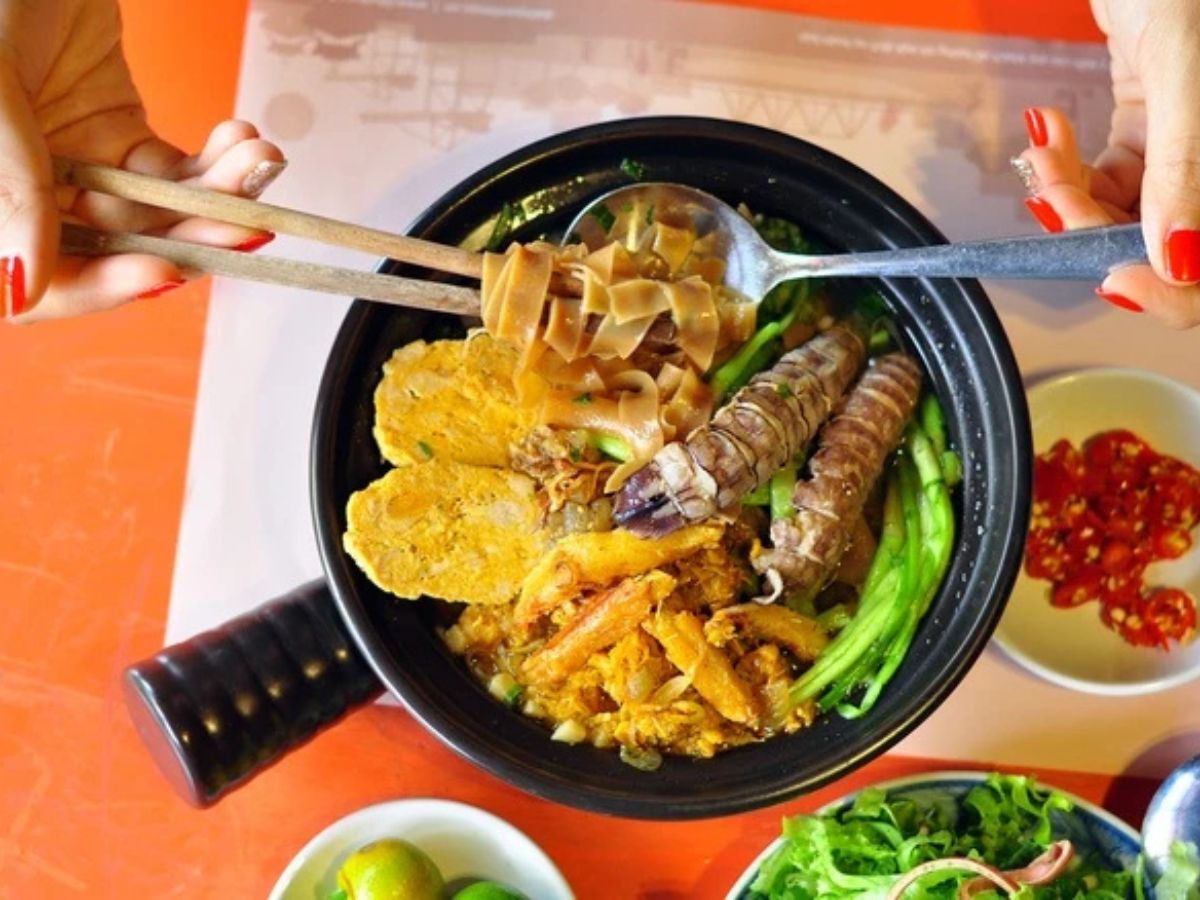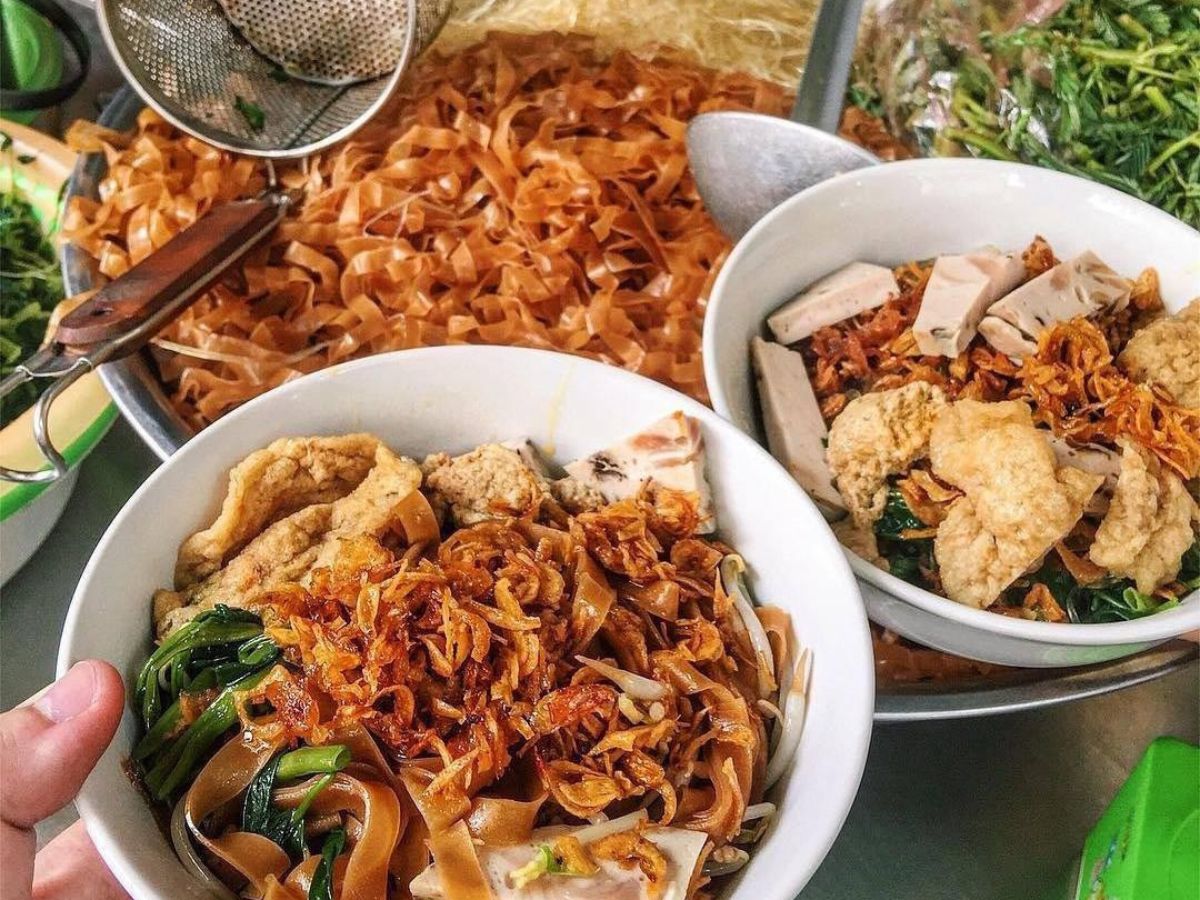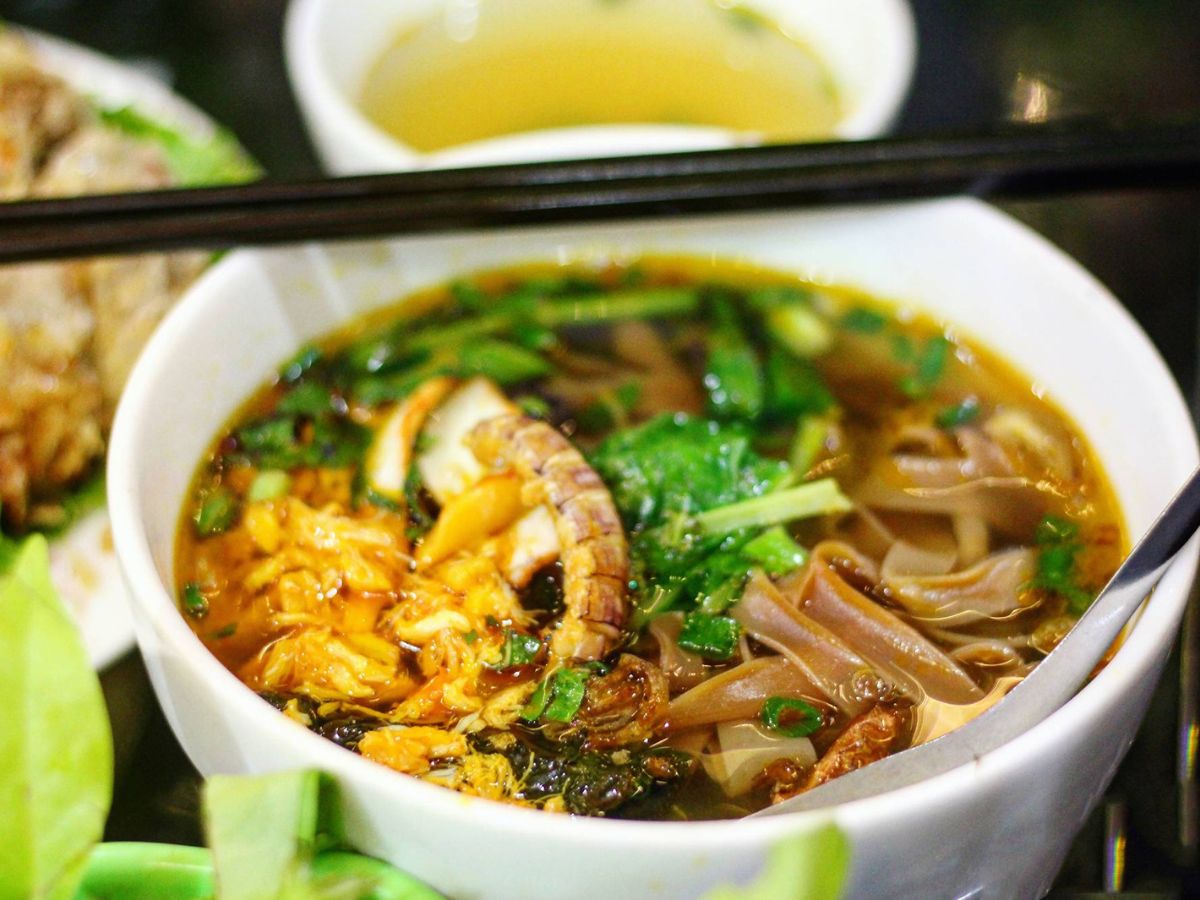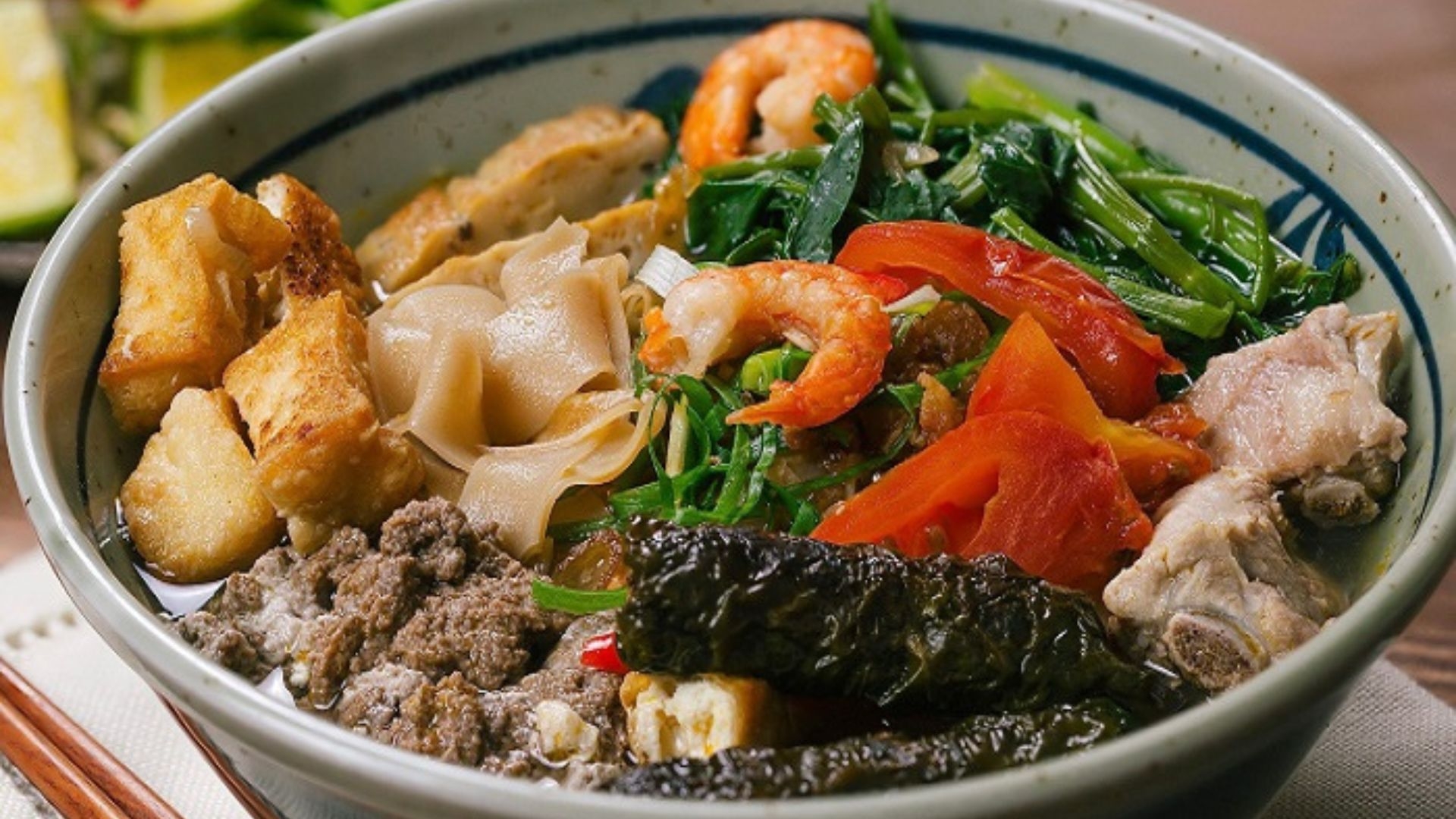1. Overview of Hai Phong Banh Da Cua
1.1. Origin and position in the culture of Dat Cang
The origin of Hai Phong Banh Da Cua is believed to have appeared around the 10th century, when the people of Dat Cang used dipped banh đa as a convenient dish on long journeys. Over time, that rustic flavor was combined with fragrant and sweet freshwater crab meat, creating a signature dish carrying the strong identity of Hai Phong cuisine.

Hai Phong crab noodle soup carries the deep cultural imprint of the port city. (Source: Collected)
Red noodle strands are not just a familiar food, but also a symbol of the familiar meals of the local people. The closeness between the dish and the life of Hai Phong people is vividly reflected through folk songs, proverbs, and folk melodies. The preparation method, though simple and rustic, pays great attention to refinement, carrying somewhat the open, honest character of this region.
Nowadays, Hai Phong crab noodle soup is still considered a core part of the local cuisine, highlighting the imprint of Northern Vietnam through the selection of purely Vietnamese ingredients and traditional preparation methods, close to the rhythm of daily life.
1.2. Outstanding Specialties of Vietnam with International Recognition
Hai Phong crab noodle soup has proudly been named among the Top 50 Vietnamese specialties, and has attracted significant attention on the international culinary platform TasteAtlas with the title of being on the list of "world's best soups". Many international culinary websites and magazines highly appreciate the harmony in color and the characteristic flavor of this dish.
Culinary experts believe that the distinctiveness of Hai Phong crab noodle soup is not only reflected in its color and presentation, but also in its unique flavor, hard to find in any other noodle soup dish. It is these local elements that make the dish an attractive highlight for domestic and international tourists.
At many major domestic and international culinary events, Hai Phong crab noodle soup is chosen as a typical representative of Northern Vietnamese culinary culture. Thanks to this, the dish has contributed to introducing the characteristic flavors of the port city to international visitors, contributing to enhancing the position of Vietnamese cuisine on the world stage.
2. Ingredients and Characteristic Flavor
2.1. Red Noodle Strands of Hai Phong
Red noodle strands have a characteristic reddish-brown color, are chewy, soft, and have a light aroma of rice, creating a unique flavor base for Hai Phong crab noodle soup.
The difference of the port city's crab noodle soup is shown through thin, chewy noodles with a subtle nutty aroma. This texture is unlike vermicelli or pho but stands out thanks to the traditional rolling and drying standards famous in Du village, Hang Kenh, which is the place supplying traditional noodles for this dish.

The characteristic red noodle strands are chewy, soft, and lightly fragrant with rice. (Source: Collected)
Each noodle strand retains the sweetness of rice and the warm color of gac fruit. When put through boiling water, the noodle strands do not disintegrate but still maintain their natural chewiness, creating an appealing chewy texture and offering a unique dining experience.
2.2. Hai Phong river crab broth
The element that makes the soul of Hai Phong crab noodle soup is the broth cooked from fresh river crabs. Crabs after being cleaned are finely ground and carefully filtered to obtain the clear, naturally shimmering liquid. Crab roe is separated, sautéed with shallots and oil to release a rich, savory aroma, then skillfully mixed with the broth, creating a delicate sweetness and rich flavor that few other dishes can match. It is this flavor that makes the bowl of crab noodle soup appealing from the very first spoonful.
The broth filtered from river crabs brings natural sweetness, with added richness from crab roe, and accompanying seasonings like fried shallots, fish sauce, and ground pepper further highlight the characteristic rich flavor. The overall saltiness is moderate, not overpowering the sweetness of the crab, creating a harmonious flavor combination.
Many long-time chefs say the secret to a delicious broth is choosing live, firm crabs and grinding them using the correct technique. Although meticulous and elaborate, thanks to this, the broth always retains its irreplaceable natural flavor.
2.3. Special accompanying ingredients and modern variations
Traditional accompanying ingredients of Hai Phong crab noodle soup usually include betel leaf sausage, fish cake, pork meatballs, peeled shrimp, shredded water spinach, bean sprouts, and sliced shallots. Each ingredient not only contributes to a harmonious flavor but also adds nutritional value, making the bowl of noodle soup more complete and appealing.
Nowadays, thanks to its proximity to the sea, Hai Phong crab noodle soup is further enhanced with various fresh seafood such as shrimp, mantis shrimp, or crab. This combination not only enriches the flavor but also increases nutritional value, offering a more diverse and modern culinary experience for diners.
Accompanying vegetables usually include fresh shredded water spinach, crisp bean sprouts, along with culantro and scallions. This light combination not only adds a fresh green color to the bowl but also brings a fresh, well-rounded taste to every bite.
3. How to prepare authentic Hai Phong crab noodle soup
3.1. Traditional method for making red noodles
The process of making red noodles begins with soaking the rice thoroughly and removing impurities, then grinding it finely and mixing it with gac fruit or sugarcane molasses to achieve the desired reddish-brown color. The coloring step requires meticulousness to ensure each batch of noodles is consistently colored.

Prepare enough ingredients to make Hai Phong crab noodle soup at home. (Source: Collected)
The manual noodle making process on a steamer is the deciding factor for quality. Experienced artisans will adjust the heat and time appropriately, so the noodles are just cooked, not dry and tough or too thin. After being made, the noodles are dried on bamboo trays under gentle sunlight.
The final steps of drying and packaging help stabilize the chewiness, softness, and characteristic rice aroma. This traditional craft has been passed down through generations, with each family holding its own secrets to produce the best and most delicious red noodles.
3.2. Secret to cooking crab broth with authentic flavor from the port city
The selection of freshwater crabs is paramount: the crabs must be fresh, firm, and of moderate size. After cleaning, the crabs are finely ground and then filtered to extract the clear broth. The roe is separated to be sautéed with shallots and oil for a characteristic aroma.
Cooking the broth requires careful measurement when adding spices. Fish sauce, pepper, and green onions are added in appropriate quantities to create depth of flavor while preserving the pure sweetness of the crab. The heat should be moderate to keep the broth clear and not diminish the fresh taste of the freshwater crabs.
Preparing the accompanying vegetables is also crucial. Shredded water spinach and bean sprouts are blanched to the right degree to ensure crispness. Toppings such as fish cake, leaf-wrapped sausage, shrimp, and mantis shrimp are prepared on-site, then layered harmoniously.
3.3. How to prepare and present a bowl of crab noodle soup
Presenting a bowl of crab noodle soup requires attention to detail, reflecting the cook's dedication. The noodles, after being blanched in boiling water, are neatly arranged at the bottom, followed by water spinach, bean sprouts, fish cake, leaf-wrapped sausage, shrimp, and mantis shrimp, creating an attractive layer of colors.
The traditional way of eating here often involves adding a little shrimp paste, chili sauce, a slice of lime, or fresh chili, to enhance the aroma and adjust to individual tastes. These condiments highlight the unique characteristics of this traditional dish from the port city.
The final step is to ladle the hot crab broth over the top, allowing the ingredients to absorb the rich crab flavor. Hai Phong crab noodle soup is best enjoyed piping hot, allowing all layers of flavor to meld and touch the diner's senses.
4. Identifying features of a bowl of Hai Phong crab noodle soup
A standard bowl of Hai Phong crab noodle soup is always appealing due to its harmonious blend of colors: red-brown of the noodles, yellow of the sautéed crab roe, fresh green of water spinach, milky white of bean sprouts, added red from shrimp and mantis shrimp, and golden highlights of crispy pork belly and green onions.

A serving of Hai Phong crab noodle soup, authentic river crab flavor, fried roe with scallion oil. (Source: Collected)
The aroma is a blend of river crab flavor, fragrant fried roe, and scallion oil, creating a distinct, recognizable aroma layer. Many food enthusiasts say that just by smelling it, they can immediately recognize the specialty Hai Phong crab noodle soup dish.
The characteristic deliciousness also lies in the harmonious combination of salty, sweet, rich, and refreshing flavors. Sometimes, the sourness of lime or the mild spiciness from chili act as accents, all blending with the rich umami of river crab, creating an impressive gustatory experience, difficult to confuse with any other soup dish.
5. Addresses and prices of Hai Phong crab noodle soup 2025
Currently, the price of Hai Phong crab noodle soup typically ranges from 30,000 to 50,000 VND depending on the location and accompanying choices. In casual eateries, the price for a basic bowl is usually from 30,000 to 35,000 VND, while places famous for abundant quality seafood charge from 45,000 to 50,000 VND per bowl.
The Crab Noodle Soup stall in front of Chu Van An Primary School is favored by many diners for its rich broth, abundant fresh seafood, spacious environment, and fast service. Prices here range from 15,000 to 40,000 VND depending on the accompanying choices.
Co Yen restaurant at 195 Cau Dat is known for its mantis shrimp crab noodle soup. It is a familiar spot for locals and visitors alike, famous for its consistent quality and flavorful broth. The average price is around 40,000 VND for a full bowl, which is very popular with tourists.

Many banh da cua eateries maintain the traditional flavor in Hai Phong. (Source: Collected)
Another suggestion is the unnamed eatery at 140 Tran Phu street, which stands out with a variety of side options and broth infused with the flavor of field crabs. Although it lacks a clear sign, the eatery is always crowded due to its reputation. The price per bowl ranges from about 32,000 to 38,000 VND, suitable for many diners.
Not only appearing in Hai Phong, banh da cua Hai Phong is also available at many eateries specializing in Northern Vietnamese dishes in Hanoi and Ho Chi Minh City. The preparation style still retains the spirit of the port city, bringing the characteristic flavor of field crabs no matter where it is.
In Hanoi, Luong Dinh Cua, Linh Lang, and Kim Ma streets are famous for banh da eateries with authentic Hai Phong flavors, attracting many customers. In Ho Chi Minh City, areas like Bui Vien and Le Van Sy also have banh da cua eateries that bring the full flavor of home, serving customers in the southern city.
6. International Recognition and the Role of Hai Phong Banh Da Cua in Culinary Tourism
6.1. Hai Phong Banh Da Cua on the World Culinary Map
On the world culinary map, banh da cua Hai Phong has made a special mark by being honored by TasteAtlas in the list of 'The World's Best Soups'. Not only attractive for its rich flavor from field crabs and sweet broth, the dish also impresses with its harmony in color and delicate presentation. The soft, chewy red banh da noodles, golden crab roe, and green color of water spinach and bean sprouts create an eye-catching whole. This perfect balance helps Hai Phong banh da cua become a pride of Vietnamese cuisine, scoring fully in the eyes of international friends.

Hai Phong crab noodle soup was honored by TasteAtlas in the list “The best soups in the world”. (Source: Collected)
Many culinary experts in other countries highly appreciate the cultural value that Hai Phong crab noodle soup brings. The skillful combination of local ingredients has created a dish with its own unique mark, difficult to blend with any other culinary style in the world.
Famous travel and culinary websites often include Hai Phong crab noodle soup in the list of must-try dishes when visiting Vietnam.
6.2. Experience Hai Phong crab noodle soup during your trip to Hai Phong
The Hai Phong travel itinerary integrates the experience of enjoying Hai Phong crab noodle soup at reputable addresses. The tour guide will share the origin of the dish, suggest quality locations, and guide you on how to fully appreciate the flavor.
When exploring Lan Ha Bay with the Sun World Cat Ba cable car or stopping at other prominent tourist spots of the port city, visitors have many options for sightseeing combined with culinary experiences. Hai Phong crab noodle soup serves as a cultural bridge, helping tourists better understand the rhythm of life and the people here.
7. Experience tips for enjoying Hai Phong crab noodle soup
Hai Phong crab noodle soup is a dish suitable for many types of tourists thanks to its rich flavors and ways of enjoying it. Young people often enjoy the lively atmosphere at small roadside eateries, where steaming bowls of banh da carry the essence of local life. Families can choose spacious restaurants with diverse menus and airy spaces to enjoy together. As for solo travelers, just stopping by any small eatery, they can easily find warmth from the smiles and friendly stories of the port city's people.

Culinary travel experience and enjoying Hai Phong crab noodle soup. (Source: Collected)
When traveling with friends, trying various cooking methods will help you easily appreciate the diversity in the flavor of Hai Phong crab noodle soup. Families with young children will find it more convenient to choose lively eateries with rich menus and spacious environments. For solo travelers, sometimes a heartfelt conversation with the owner about the dish's origin or how to enjoy it is enough to make the trip more memorable.
You can recreate the flavor of Hai Phong crab noodle soup at home if you prepare enough ingredients such as red noodles, fresh river crab, water spinach, bean sprouts, fish cake, and betel leaf sausage. The process includes cleaning the crab, extracting the broth, and sautéing the crab roe with shallots and oil to release a special aroma.
Next, the noodles are boiled until soft, the vegetables and bean sprouts are blanched just right, along with the prepared toppings. When served in a bowl, place the noodles, vegetables, and toppings on top and ladle the hot crab broth over them. With just a few steps and some skill, you can cook and enjoy the authentic Hai Phong flavor of crab noodle soup right in your own kitchen.
Hai Phong crab noodle soup is a prominent feature in the Vietnamese culinary landscape, being both familiar and rustic, yet offering a refined and profound taste experience. Recognized by international friends, with reasonable prices and widespread popularity, this dish has become the pride of the people of the port city. For food-loving travelers, red Hai Phong crab noodle soup is always a worthwhile experience, evoking the simple yet sophisticated flavors of Vietnamese cuisine.








